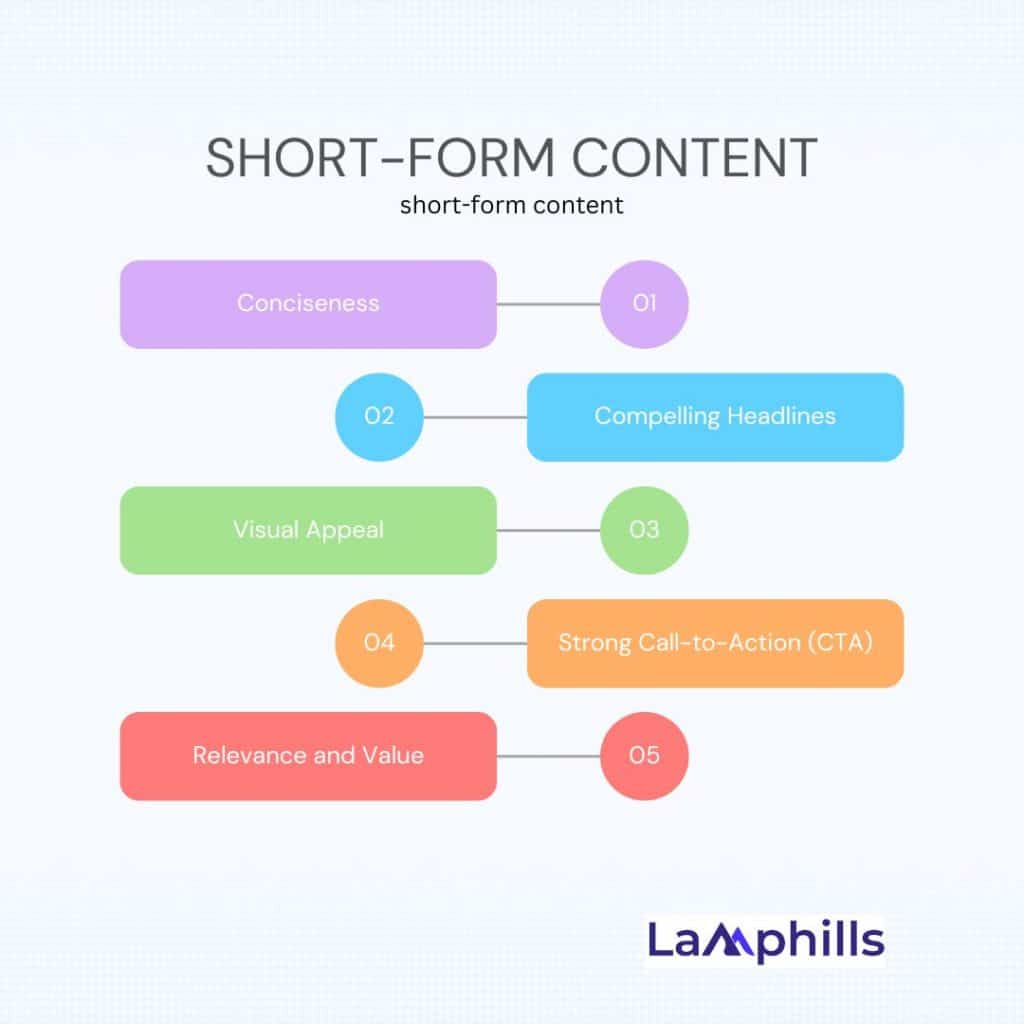Long-form content seems to be the gold standard when it comes to content marketing. However, short-form content has proven to have its own benefits when done right. I realized this when a social media post I crafted in under 10 minutes went viral and gained a lot of engagement while I was still struggling to come up with long content for the same purpose. There’s a time to use long-form content; there’s equally a time to use short-form content, and that’s what I will show you in this article. Read on.
Key Takeaways
- Short-form content is content that is brief and to the point, typically under 1,000 words,
- Short-form content can be in the form of social media posts, blog snippets, email newsletters, and infographics.
- The elements that make up effective short-form content include conciseness, visual appeal, compelling headlines, strong Call-to-Action, relevance, and value.
What is Short-form Content?
Short-form content, as its name implies, is content that is brief and to the point. Typically, it is under 1,000 words, but it can be even shorter, depending on the platform you use and its purpose. Short-form content can take different forms:
- Social Media Posts: These include tweets, Instagram captions, Facebook updates, and LinkedIn posts. Each of these platforms has its own character or word limits, encouraging brevity.
- Blog Snippets: Short articles or blog posts that deliver a quick, focused message. These are often used to provide updates, share news, or offer concise tips.
- Email Newsletters: Short, impactful messages sent to subscribers, often used to announce new products, share updates, or provide valuable insights.
- Infographics: Visual representations of information or data designed to be quickly understood and shared. These are particularly effective for simplifying complex information.
Think of a tweet, an Instagram caption, or a quick LinkedIn update – all these are classic examples of short-form content. These pieces are designed to grab attention quickly and deliver something that can easily be taken in.
Benefits of Short-form Content
Short-form content has a lot of benefits, which include:
#1. Engagement
One of the most significant benefits of short-form content is its ability to generate high engagement. People today have shorter attention spans and are constantly bombarded with information. By keeping content concise, you cater to this user behavior, making your audience more likely to read and interact with your message.
Short-form content grabs attention quickly. A striking image, a compelling headline, or a provocative question can draw readers in instantly. And because it’s quick to consume, readers can engage with more content in less time. This increases the number of interactions you can achieve.
Another value engagement gives you is increased comments and shares. The simplicity and clarity of short-form content often make it more shareable and more likely to spark conversations.
#2. Shareability
Short-form content is inherently more shareable. Think about it: you’re more likely to share a quick, insightful post than a lengthy article. This shareability extends your reach, allowing your content to spread more organically across social networks.
The concise nature of short-form content makes it ideal for social media, where users prefer quick reads and visual content. A well-crafted short piece can go viral quickly. Also, encouraging your audience to create and share their own short-form content related to your brand can further enhance shareability.
#3. Mobile Friendliness
With the majority of users accessing content via mobile devices, short-form content is perfectly suited for mobile consumption. It fits well on smaller screens and can be quickly read on the go.
Short paragraphs, bullet points, and visuals ensure that content is easily readable on smartphones and tablets. Also, users can consume content during short breaks, while commuting, or whenever they have a few minutes to spare.
Mobile-friendly content also contributes to a better user experience, reducing bounce rates and encouraging longer site visits.
#4. Frequent Posting
Creating short-form content takes less time, which means you can produce and post more frequently. This consistent presence helps keep your brand top-of-mind for your audience. Posting regularly keeps your audience engaged and informed, showing that your brand is active and responsive.
Additionally, producing short-form content generally requires fewer resources, making it a cost-effective strategy for maintaining a robust content calendar.
#5. SEO Benefits

When optimized correctly, short-form content can boost your SEO efforts. By targeting specific keywords and maintaining relevance, these pieces can improve your search engine rankings.
- Keyword Optimization: Short-form content allows for focused keyword optimization, targeting specific queries that your audience is searching for.
- Increased Page Views: Frequent posting of short-form content can lead to more indexed pages, increasing your website’s visibility.
- User Engagement: High engagement rates signal to search engines that your content is valuable, potentially improving your rankings.
Characteristics of Effective Short-form Content

#1. Conciseness
Effective short-form content is clear and to the point. Every word counts, so the message needs to be concise yet impactful. There is less use of unnecessary words as the whole aim is to deliver your message as fast as possible. Short-form content also uses short sentences and paragraphs to maintain reader interest and comprehension.
#2. Compelling Headlines
The main aim of short-form content is to attract and engage readers, and this is reflected in the title (or rather, headlines). Since it is the first thing that your audience sees and determines whether they will engage with your content, the headline should always be strong and attention-grabbing.
#3. Visual Appeal
Incorporating visuals like images, videos, and infographics can significantly enhance the appeal of short-form content. Visuals help break up text and make the content more engaging. Examples of visuals include high-quality images, videos and infographics.
#4. Strong Call-to-Action (CTA)
An effective short-form content includes a compelling CTA that encourages reader engagement or conversion, whether it’s liking a post, sharing it, or clicking a link.
#5. Relevance and Value
Despite its brevity, short-form content must provide immediate value and relevance to the audience and succinctly address their needs or interests.
Best Practices for Creating Effective Short-form Content
The main purpose of creating short-form content is to convey information and drive engagements in as little time as possible. That is to say that if your readers do not understand the message you’re trying to pass, your efforts may have been futile. So, how do you tailor your content to achieve this? Follow the best practices below:
#1. Know Your Audience
It’s very important you know and understand the preferences and behaviours of your target audience. It’s useless to create content for people who would rather spare their time to get all the information they can get on a subject. Follow these simple steps:
- Audience Research: Conduct surveys, interviews, and social media listening to gather insights about your audience.
- Segmentation: Segment your audience based on demographics, interests, and behaviours to create more targeted content.
- Personalization: Use personalized messaging to make your content more relevant and engaging.
#2. Focus on One Key Message
Keep your content focused on one main idea or message. This helps maintain clarity and ensures that your audience grasps the intended point quickly.
- Define the main objective of each piece of content before you start creating it.
- Use a simple structure with a clear beginning, middle, and end to convey your message effectively.
- Avoid including unnecessary information that can distract from your main message.
#3. Use Strong Visuals
Incorporate images, videos, and graphics to capture attention and make your content more engaging. Visuals can convey information more effectively than text alone.
Use professional-quality images and videos to enhance your content. You can also incorporate video storytelling to illustrate a point in a way that text alone cannot. Also, maintain a consistent visual style to reinforce your brand identity.
#4. Optimize for SEO
Use relevant keywords, meta descriptions, and hashtags to optimize your content for search engines. This helps improve visibility and reach.
- Identify relevant keywords and incorporate them naturally into your content.
- Write compelling meta descriptions that accurately reflect the content and include keywords.
- Use relevant hashtags on social media to increase discoverability.
#5. Encourage Engagement
Include interactive elements like polls, questions, or comment prompts to foster engagement and interaction with your audience.
- Interactive Content: Use quizzes, polls, and interactive infographics to engage your audience.
- Questions and Prompts: Encourage your audience to share their thoughts and opinions by asking questions or including prompts.
- Respond to Engagement: Actively respond to comments, shares, and other forms of engagement to build a sense of community.
Read Also: Interactive Facebook Posts: Level Up Your Marketing Strategy
#6. Track Performance
Utilize analytics tools to measure the performance of your content. This data can help you refine your strategies and improve future content.
- Key Metrics: Identify key metrics to track, such as engagement rates, reach, and conversion rates.
- Regular Monitoring: Regularly review your analytics to understand what’s working and what isn’t.
- Continuous Improvement: Use the insights gained from your analytics to refine your content strategy and improve future content.
Here’s a checklist to help you create impactful short-form content:
Read Also: How To Measure Reach: Effective Tools and Strategies
Some Popular Short-form Content Platforms
Short-form content can be utilized on a variety of platforms, each catering to specific audience demographics. These platforms include:
#1. TikTok
TikTok is the most popular platform for producing short-form content. It specialises in ultra-short content creation. Its intuitive design and innovative features have transformed communication for brands and individuals. The app’s brief video format fosters creativity, giving rise to viral trends and challenges.
TikTok’s algorithm ensures tailored content delivery, reaching the right audience. Brands harness its vast global user base to craft visually engaging, succinct content ranging from tutorials, humour, and storytelling, helping marketers to establish authentic audience connections with their audience.
#2. LinkedIn
LinkedIn is an excellent platform for sharing industry insights, company updates, and thought leadership pieces. When it comes to sharing content, make sure it is genuinely useful and professional. There are a lot of influential people on LinkedIn so you’ll want to present your brand in the best way possible. So, you’ll make sure to avoid clickbaits or inflammatory content!
#3. YouTube
With over 2.7 million active users, YouTube is a powerful long and short-form video platform, offering a vast audience base and extensive reach. According to Think With Google, 80% of consumers say they switch between online search and video when researching products, and 50% say online video has helped them make a final purchase decision.
YouTube is great for helping customers solve problems, demonstrating products or services, and telling the story of your brand and its people. For example, with your own branded YouTube channel, you could incorporate some how-to videos, include some event or behind-the-scenes content, or introduce team members. Think about what your audience will respond to on an ongoing basis and try out some ideas.
#4. Instagram
Instagram is another popular platform that is great for producing short-form content. With 1.21m monthly active users, Instagram, particularly Instagram Stories and Reels, is tailored for short-form visual content, making it ideal for visually appealing brands. As with the platforms we mentioned above, it’s about finding an enduring theme or compelling one-off posts and testing to see what resonates with your audience – so don’t forget to check your engagement analytics regularly and adapt your strategy accordingly.
#5. Facebook
Facebook offers diverse content formats, including short-form videos, carousel posts, and photo albums, catering to different audience preferences.
Challenges of Short-form Content
#1. Depth of Information
One of the main challenges with creating short-form content is the limited space to convey complex ideas or detailed information. This can sometimes lead to oversimplification of important topics.
#2. Competition
Capturing attention with short-form content in a crowded digital space can be challenging. Your content needs to stand out among a crowd of other posts and updates. You can mitigate this by doing the following:
- Develop a unique voice and style that sets your content apart.
- Consistently produce high-quality, valuable content that resonates with your audience.
- Experiment with different formats, such as videos, polls, or quizzes, to keep your content fresh and engaging.
#3. Consistency
Maintaining a consistent voice and quality across multiple short pieces of content can be difficult, especially when posting frequently. Implementing the following can help:
- Editorial Guidelines: Establish clear guidelines for tone, style, and quality to ensure consistency.
- Content Calendar: Plan your content in advance to maintain a consistent posting schedule.
- Quality Control: Regularly review and edit your content to ensure it meets your standards.
#4. Measuring Impact
Tracking the direct impact of short-form content on long-term goals can be challenging. Metrics like likes, shares, and comments provide some insight but don’t always tell the whole story.
By implementing the best practices I have mentioned earlier, you can mitigate these risks and create more engaging and useful content.
In Conclusion
Reflecting on my experience with using both long-form and short-form content, I can confidently say that short-form content holds immense potential in digital marketing. Its ability to engage, be shared, and fit seamlessly into the mobile experience makes it indispensable. And by implementing best practices and understanding its unique challenges, you can harness the power of short-form content to enhance your brand’s online presence.
Related Articles
- Short-Form Content vs. Long-Form Content: Understanding the Key Differences and When to Use Each
- What Is a UGC Content Creator? A Guide to Becoming One in 2024
- Content Monitoring Process: How I Mastered Content Monitoring Using Tools, Techniques, and Best Practices for 2024
- Brand Marketing vs. Content Marketing: How They Differ and Work Together






